#Hudson Valley art gallery
Explore tagged Tumblr posts
Text
dead boy detectives characters as art objects and sculptures; extended ---
hello, i remembered i made some subjective explanations and notes on few of my choices for this post, and i thought some folks might enjoy it. soo let's get into it.
1.
monty finch
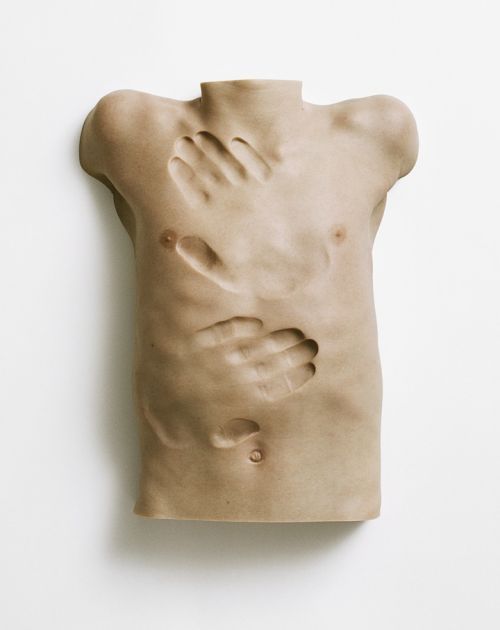
author: anders krisár
pretty self-explanatory; it's a moulded male torso with visible inprints on its skin.
anders krisár’ artistry explores the themes of loss, separation, and the condition of the psyche through the lens of a human body in duality: perfectionism meets unsettlement, skin meets marble and bronze and polyester, to create sculptures spanning geological time far beyond the living's capabilities.
monty's creation by esther was already stripped of any human agency. "he was made a boy, not a person", small, almost doll-sized, with a singular purpose: to seduce and entice the chosen dead boy into their doom. the naked skin and specifically the position of its arms are mildly erotic, but in a way that makes your skin crawl. the imprints are intimate, placed possesive; notice the thumbs digging close to especially sensitive areas like nipples and the belly button.
the latter seems to connect the "creator" to the subject, the navel here as a symbol of cruel, invasive motherhood. the fact that the torso is cut off in the middle and at the neck furthers the uncanny valley feeling of a young male body, but then again. this is a realistic portrayal. so was it ever a person? what does it have inside to make dents so profound? how deep you can press until it breaks?
--- i'm leaving out crystal and edwin (for now?), but @nicheoverhere brilliantly noticed that it was the same author for both. that was intentional! because glen martin taylor is all about taking kintsugi, which is a beautiful art form of repairing fine china and generally delicate things with veins of precious metals, but with materials like— nails. scissors. barbed wire. all ugly. the repair after a great shattering is seldom pretty after all, they really are similar in this regard. ---
2.
charles rowland
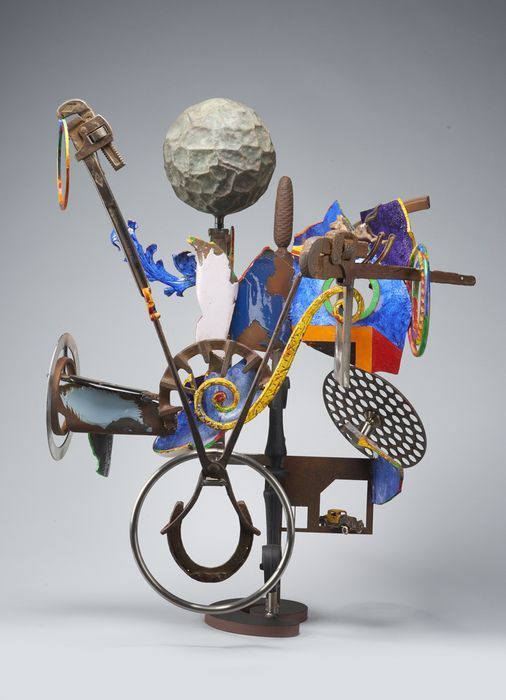
author: robert hudson
okay, strap in. this funky dreamy world belongs to robert hudson, and i picked it for charles rowland because it's all first impressions. the colours? the composition? they give you the 80s vibes, almost; like something a kid would design if you asked them what a time machine would look like. it could probably move in several ways. the pieces seem mismatched, but hold themselves together surprisingly well. or maybe you underestimate it?
it's neither big nor small. you can't tell its size at all. it's a bit overwhelming to look at, at first, and at second, and after a while, but it carries that comfortable familiarity and nostalgia for— well, nothing in particular, because the longer you look, the sadder its past seems. the bold pops of contrasting colour are fighting for your attention. they want you to like it! and yet, the major material seems to be just. rusted steel. made from tools.
and look at that botched up sphere, it wants so badly to be a perfect sphere and it knows it'll never be one. fine!! perhaps it could be a football ball instead! or maybe a head. if you close your eyes, that is. and this facing-up horseshoe? a lucky charm, made to collect good luck and keep it from falling out cause god, it needs it.
---
3.
niko sasaki

author: justin cloud
---
niko sasaki, now how do i describe her? let's start by saying— she's cleary a her. this one is a she. and there's something to be said about blooming, and femininity, and delicacy, because pink is a hopeful girly colour and a surprise and a delight.
what are you doing in a gallery, little flower, shouldn't you be at home? in a field? look how pretty you are! mind you, of course there's something wrong with her as well, but you're not sure if that is because someone messed it up, or because of a different entity alltogether. was it always half-electric? its elegance seems purposeful— the iridescent metal fits all too well with the white-pink petals— but also uncanny. and oh suddenly you can't stop looking at the stigma from which a pollen should release aaany time now.
when i look at her, at her black artificial stem and the small leaves imitating the real ones, i wonder if she doesn't want to lure me into a trap. is it her fault?
the beautiful petals seem like the only thing left real of the flower. whichever way she turns, it will probably mean— death. and flowers are ephemeral. what is a flower mounted to a wall, fortified with steel, connected with cables and enfused with electrical energy, then?
i think she's a self-preserving survivor. ---
4.
the night nurse
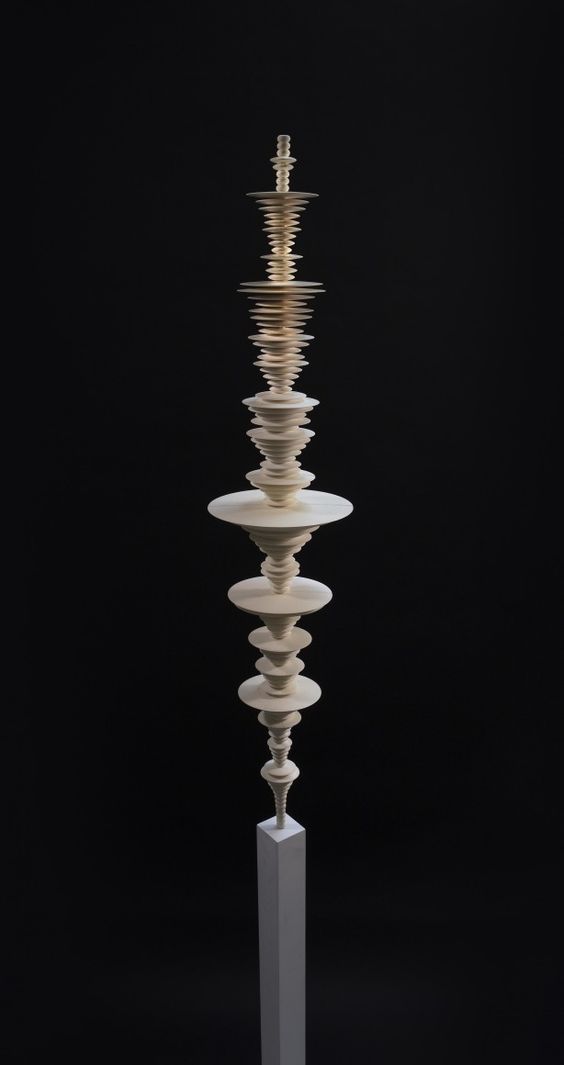
author: elizabeth turk
---
now. the night nurse.
of course it's the only piece in the collection where the background needed to be dark. no one here is older than her. there is no inoffensive, fading-into-background white for this absolute pillar of truth. or maybe something like a totem, quite protective in nature. and it's terrifying, 'cause you're immediately hit with the feeling that you're looking at something out of this realm, something you're not supposed to witness. the perspective is all wrong. is it downwards or upwards? why does it seem unstable when the pieces are so perfectly centered and seemingly well-balanced? child, you should calm down, it's not like you will destroy it with a stronger puff of air. will you?
this sculpture is called "tipping point — echoes of extinction", and it's actually a mix of technology and sculpture and sound, with elegant visualizations of the lost voices of birds and sea mammals. the author said it "was conceived in reverence to the astounding lives the species which envelop humans have lived and the mysterious ways they have contributed to our well-being. the shadows of their memory, whether a shape or a sound, have inspired this project." so the piece deals with death. moreover, it deals with murder. it records the harsh reality and makes sure the ones that suffered horribly at the hands of humans are, in a way, celebrated. but also— categorised. like epitaphs. the birdsong, once a living sign, is only visually represented by the lines of varying lenghts in 3D, and you can do nothing about it anymore, right, you can't bring back the dead, you can't help the innocent dying in any way other than— stacking them on top of each other and moving on.
---
so that's for now, i might someday write more if anyone's curious. :")
#dead boy detectives#dbda#dbda meta#dbda analysis#edwin payne#charles rowland#crystal palace#niko sasaki#the cat king#monty finch#monty the crow#the night nurse#jenny green#jenny the butcher#dbda edit#moodboard#art objects#objects#sculpture#art#character analysis#this is me trying to get into the core of them by the way. the very essence if you will#not specifically and not only their trauma but overall vibes#if we have hardcore art critics here. sorry. it's not really art crit#marcela writes#marcela watches dbda
119 notes
·
View notes
Text

Lake George Reflection (1921–1922) 🎨 Georgia O'Keeffe 🏛️ Private Collection 📍 Somewhere
Painted circa 1921-22, Georgia O’Keeffe’s Lake George Reflection embodies the contradictions inherent in the artist’s best work which came to define her career and cement her legacy as one of the most enduring and intriguing figures in 20th-century American Art. Lake George Reflection, the most ambitious in scale of her works from the 1920s, is a meditation on the sublime, building upon the tradition of the 19th century Hudson River School artists who sought to capture the drama and beauty of the unspoiled landscape surrounding Lake George. Presented alternatively as both a vertical and horizontal composition, the work is an expression of the artist’s experimental thought process as she considered what it meant to be representational in an age of burgeoning abstraction in American Art. Horizontally, the painting exemplifies the boldly colorful landscapes which have become a hallmark of O’Keeffe’s career, foreshadowing the abstracted paintings of the New Mexico hills from her later years. When viewed vertically, as Lake George Reflection was first exhibited in 1923 at the Anderson Galleries, the infinite horizon shifts to a powerful vertical thrust, with the formerly symmetrical reflections of the landscape morphing into the interior folds of a magnified flower or echoing the bold and daring heights of a New York City skyscraper. This ambiguity of orientation results in a painting that is at once highly representational and wholly abstract, carefully constructed and malleable, and which defines the subtle power of O’Keeffe’s most dramatic and admired works. O’Keeffe signified the importance of certain works by including a hand-drawn star on the reverse or backing board; she noted this distinction on the verso of Lake George Reflection.
On June 10th, 1918, Georgia O’Keeffe moved to New York City. That August, she visited Lake George in the Hudson River Valley with Alfred Stieglitz, the influential photographer and art dealer twenty years her senior whom she would marry in 1924. On this first extended trip to the area, the Stieglitz family’s 36-acre retreat provided a welcome respite from the city, and one that afforded creative inspiration and freedom. “Stieglitz, like many urbanites then and now, also had a rural base, at Lake George in upstate New York, and every year he joined other members of the large family at his mother's home there. In August 1918, he was accompanied by O'Keeffe, who was warmly received by the mater familias and the sundry siblings, in-laws, and offspring of the Stieglitz tribe." (Georgia O'Keeffe, New York, 1991, p. 39) Over the next decade, O’Keeffe and Stieglitz frequently visited Lake George, spending most of every summer and early fall on the family compound, first at ‘Oaklawn’ and later at ‘The Hill.�� The landscape and its environs seemed to stimulate her creatively and she often referred to it as ‘perfect.’ The flora and fauna, and the relationship she developed with botanist Donald Davidson, a Stieglitz family cousin, provided veritable fertile ground for artistic discovery.
Just as Lake George exhilarated O’Keeffe, it also ushered in a period of creativity and artistic exploration for Stieglitz, allowing him to view the landscape through new eyes. “Although in earlier summers he had all but overlooked the landscape at his family’s home in Lake George, New York, he now began to photograph it, stimulated both by O’Keeffe’s infectious enthusiasm for the natural world and her own paintings of the area. Citing her ability to put ‘her experiences in paint,’ Stieglitz wrote that he too endeavored to ‘put his feelings into form’ in his photographs of the trees, barns, and buildings, as well as the landscape and clouds that surrounded him.” (B.B. Lynes, Georgia O’Keeffe, 2001, pp. 26-27) Whether sparked by lively competition or simply that O’Keeffe’s admiration of the landscape invigorated Stieglitz, both artists created some of their most bold, dynamic and experimental imagery during this time. Barbara Buhler Lynes notes, “Stieglitz’s investigation of equivalence began in the early 1920s at Lake George. O’Keeffe was involved with a parallel effort, working with color as Stieglitz had worked with light. Both his photograph and her painting suggest grand panoramas and infinite distances, while at the same time that vastness is overridden by patterns of flat, undulating shapes.” (Georgia O’Keeffe, 2001, p. 38)
In addition to the myriad of visual delights that the great view from the property afforded, it would not have been lost on O’Keeffe that she was on hallowed artistic ground. “As any visitor to Lake George, then or now, she would have been more aware of its role as a popular tourist destination reaching back to the early 1800s. In the wake of the French and Indian War (1754-63) and the American Revolution (1775-83), it captivated the hearts and minds of Americans, who were increasingly nostalgic about their history. The 1826 publication of James Fenimore Cooper’s The Last of the Mohicans sealed Lake George’s fate as an American icon.” (Modern Nature: Georgia O’Keeffe and Lake George, p. 23). Many 19th century predecessors captured the autumnal foliage, verdant hills and crystalline lakes, putting forth a vision of the landscape as untouched and unspoiled. These Hudson River School depictions, often dramatized with sunrises and sunsets, emphasized the sublime in nature, a concept that would have no doubt interested O’Keeffe. “Over the past two centuries, the concept of the sublime—with its immediate sensation of awe inspiring infinite space and evocative color and light directly internalized to moments experienced in our own lives—has been substantially redefined by a small number of artists, writers, and critics, for whom it has become a vital source of spiritual values at times of increased secularism.” (Georgia O’Keeffe: Visions of the Sublime, 2004, London, p. vii)
Seen as a landscape, Lake George Reflection is a meditation on the awesomeness of the open countryside of upstate New York found only a short distance from the hectic metropolis. Incorporating the groundbreaking experimentations from her early career, the rolling hills and water are depicted in the undulating forms so prevalent in O’Keeffe’s early abstractions of the previous decade. Similarly, the bulbous forms that line the foreground recall her abstract ‘Special’ series, also executed at Lake George a few years earlier. Taking these elements one step further, all is reflected, creating a virtual mirror image bifurcated by a dramatic horizontal cross-section. With its monumental scale, the resulting image echoes the images of sublimity in 19th-century art, which captured the grandeur of the landscape, an untouched splendor and a vastness seemingly born from the imagination. Lake George Reflection similarly suggests a landscape of infinite scale, confined by but not limited to the expanse of the canvas.
For the exhibition at Anderson Galleries in 1923, the first time Lake George Reflection was exhibited, O’Keeffe dictated that the painting be hung vertically. While the title suggests a certain formal interpretation to her work, the adjustment of orientation altered the viewer’s understanding of it, particularly when viewed in context with other work from the period. The change solely in orientation of Lake George Reflection, not to the painting, forces the viewer to understand the forms in a different manner. Marjorie Balge-Crozier describes this phenomenon in O’Keeffe’s works from this period, writing, “Manipulation of scale, depictions of fragments, precise lines and blurred edges, bold colors—all of these devices are used to create works that are emotional equivalents for her experiences. These are devices that can also elicit feelings of uncertainty, awe, and even terror in the spectator, whether one is looking at a close-up view of a flower or the splitting darkness of the Black Place. Paintings that are extremely minimal can appear at first as objects for calming meditation, then dissolve into uneasy questions of identity, with hills resembling body parts. In the end, the spectator is left with an equivalent sublime experience.” (Georgia O’Keeffe: Visions of the Sublime, p. 103)
Particularly when understood vertically, Lake George Reflection encourages anthropomorphic comparisons. Sharyn Udall explains, “Some of her landscapes do contain forms that—perhaps without any conscious intention on her part—insist on some relationship to the body. At Lake George in 1919 O’Keeffe produced several paintings of bifurcated glowing forms that begin as landscape but become increasingly abstract.” (Georgia O’Keeffe: Visions of the Sublime, p. 118) As a vertical work, the painting most closely relates to her magnified flower imagery, which she was simultaneously exploring. In works such as Flower Abstraction (1924, Whitney Museum of American Art), undulating lines and soft coral tones are quite clearly evocative of the delicate petals of a flower but the cragged vertical white line serves to bisect the image, echoing the compositional format of Lake George Reflection. Other more abstract works from the period, including Music—Pink and Blue No. 1 (1918, Seattle Art Museum) which was also in the Anderson Galleries show of 1923 and Grey Line with Lavender and Yellow (1923, Metropolitan Museum of Art), are similarly suggestive.
While O’Keeffe’s works, such as Lake George Reflection and her iconic flower paintings, seem to inherently suggest comparisons with the human form, something she patently rejected, the evolution of O’Keeffe from daring female Modernist to a sexualized media sensation was undoubtedly fostered, if not masterminded by Stieglitz. Beginning in 1918, he created a series of photographs which depicted O’Keeffe in the nude. “As art critic Henry McBride put it: ‘It made a stir. Mona Lisa got one portrait of herself worth talking about. O’Keeffe got a hundred. It put her on the map. Everybody knew the name. She became what is known as a newspaper personality.’ Moreover these photographs forged the first public image of O’Keeffe. She was seen as a sexually liberated, modern woman, and this idea of her became a visual equivalent of Stieglitz’s ardent and ongoing promotion of O’Keeffe’s art as a direct manifestation of her sexuality.” (B.B. Lynes, Georgia O’Keeffe, 2001)
Regardless of the source of these intimate connotations attributed to her most admired artwork, Lake George Reflection reflects the pictorial strategies that O'Keeffe developed as an avant-garde American Modernist: interest in a type of heightened realism that pushes an image to the edge of abstraction. It is this near abstraction that evokes the mystical and spiritual qualities that O'Keeffe associated with her organic subjects and which are the source of their strength. Hunter Drohojowska-Philp emphasizes the role of Lake George Reflection in pioneering this element of O’Keeffe’s best work, explaining, "In the spring of 1923, O'Keeffe incorporated Stieglitz's cloud motif into a pair of abstractions redolent of her earlier interest in Art Nouveau, Pink Moon and Blue Lines and Red Lines. Pink Moon and Blue Lines returns to a palette of magenta, lemon, and aqua arrayed in vertical waves on either side of a pink moon on a deep blue ground. She knew she was breaking down aesthetic barriers. Later, she said, 'When I entered the art world…you weren't supposed to paint yellow…and pink pictures.' Red Lines shows vertical waves of pale blue and buttressing columns of deep red divided by a think pink line. Both compositions derive from O'Keeffe's bisected canvases of the Lake George horizon, but upended. This technique began in her show with the vertical display of Lake George Reflection, a predictable landscape except that the horizon line runs up and down and is enlivened with pastel bubbles. Collector Peggy Guggenheim admitted that she could not decide which way to hang it. Studying photographs taken from various perspectives was enhancing O'Keeffe's ability to paint pictures that could be interpreted in multiple ways--paintings that could be hung vertically or horizontally." (Full Bloom: The Art and Life of Georgia O’Keeffe, New York, 2004, p. 219) Painted at the height of O’Keeffe’s most courageous and innovative creative output, Lake George Reflection confirms her prowess as a master colorist, daring modernist, avant-garde thinker and provocateur.
#Lake George Reflection#Georgia O'Keeffe#Private Collection#1921#1922#oil on canvas#oil painting#painting#American Modernism#Modernism#american#art#artwork#art history
35 notes
·
View notes
Text


Avery Hudson; romantic, overachiever, party animal
introduction under the cut...
Avery Hudson has lived in San Myshuno all his life, raised by his loving mother while occasionally visiting his father in Del Sol Valley. Growing up, Avery struggled with his identity and felt isolated due to his sexuality. Despite his vibrant city life and passion for technology, he longed for genuine connection. Known for his lively social life and unforgettable parties, Avery was also a true romantic. He grew tired of superficial connections on Cupid's Corner and wanted something real. With the support of his close friends, Allison and Mabel, Avery decided to step out and seek love in everyday moments. One evening at a local art gallery, Avery met someone who seemed to genuinely understand him. This chance encounter felt different—real and promising. As Avery embraced this new connection, he hoped it would finally fulfill his longing for a meaningful and lasting relationship. Will it last?
#the sims 4#ts4 gameplay#sims 4 gameplay#my sims#introduction#ts4 edits#storyline#ts4 story#my sim introduction#Avery Hudson#the sims community#simblr#jigawattsims#maxis match#wcif friendly
2 notes
·
View notes
Text
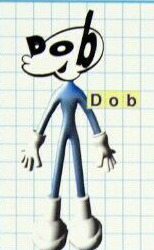
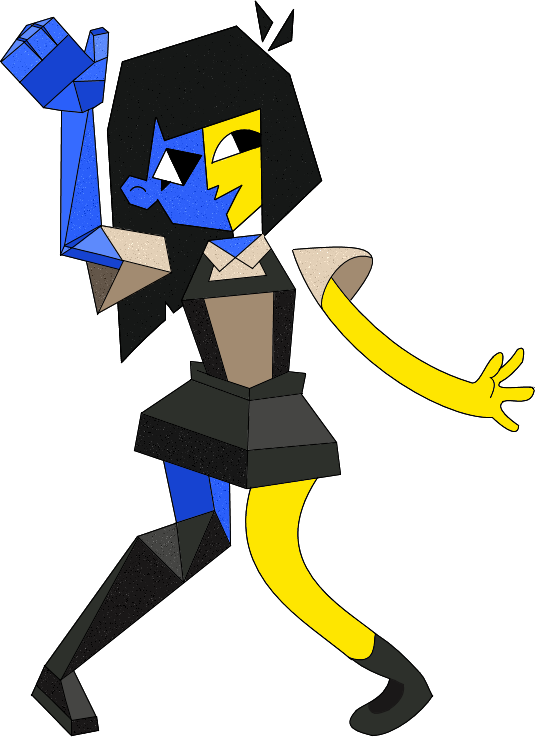
#PlanetDob #PlanetDobPs1 #ENA #ENAJoelG #CrossoverArt #MyThoughts
I would love a crossover image of Dob from Planet Dob with ENA from Ena.
They both would seem to be good pals since both are pretty weird in a cool way.
Images and videos not mine but links are there.
Planet DOB Wiki | Fandom
ENA (Animated Series) | Heroes Wiki | Fandom
[PS1] Planet Dob - psychedelic adventure from Hudson - YouTube
ENA - Auction Day - YouTube
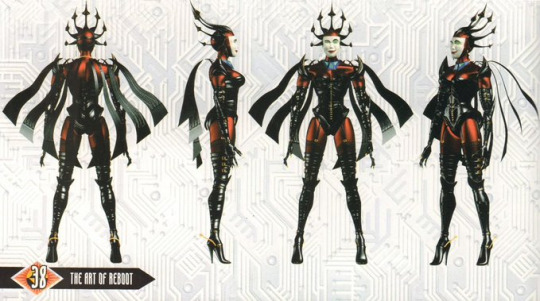
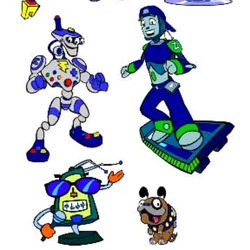
When I first saw Ena change faces and body she gave me Hexadecimal from Reboot vibes mixed with Zoogs.
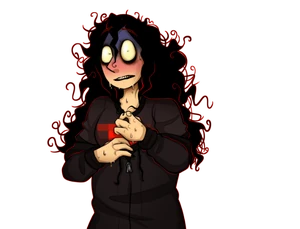


I would love a crossover image of John Doe from the John Doe game with ENA from Ena but as a yousona traveling to the uncanny valley.
John Doe could just be Ena's partner character like Moony or just a random character she meets.
I can see Ena fall for Maison Talo's buyer house trick trap.
I can also imagine his character intro being a black silhouette of his house body and his lurebody walking through the door to greet Ena and giving her the business card as a inventory item.
Images not mine but links are there.
Maison Talo's house is from the game Househunted that Mortisfox made.
Uncanny ENA AU
--------------------
I imagine this Ena writing with a penpal to a random person in the uncanny valley then finally decided to visit her penpal.
Ena asking everyone a question while holding the handwritten letter.
Having Realtors lying about the penpal being inside of their housebody.
Have Ena appear in her room writing to her pen pal which is a mystery to her wanting to met up.
Then the episode starts with Ena on a bullet train like bus that takes you to different worlds.
Kind of like the polar express with the bus driver's hand.
Ticket punch - Wikipedia
Then have Ena not having her ticket and freaking out then have the bus driver laugh and punching the ticket with it's ticket puncher hand.
Have ENA interact with the bus patrons to get their stories.
When ENA arrives in the Uncanny Valley I can see her looking around in awe.
While off screen see a male Zable realm jump hitting the top of the bus screaming as a easter egg.
Maybe have one scene where Zable interviews ENA wanting to know where he is and becomes a party member.
Then end up meeting a Realtor trying to lure both of them in but Zable says this fool smells moldy then the Realtor gets too offended by that comment.
Have the Realtor try to trick the both of them to get inside of the house to be eaten.
The Ena in this AU has a hourglass dog as a service animal.
I can see this dog protect her and help her out.
I can see this ENA with her service animal hourglass dog talking to everyone in the Uncanny Valley while avoiding being eaten by anyone with male Zable.
With ENA trying to figure out what her penpal's looks like from the sketch of themself which is a okay sketch of John Doe.
This ENA would think this Uncanny Valley place is weird but interesting in a abstract art kind of way.
I would name the male hourglass dog Nugget.
A song I liked.
Video not mine but link is there.
Radio - My House (youtube.com)
What the song reminds me of.
I Just Died In Your Arms Tonight - Cutting Crew (Lyrics) [HD] (youtube.com)
Scopophobia Studios - itch.io
The Art of ReBoot - Hexadecimal’s final model... - Everything's Gone 8-Bit! | 8 bit, Reboot, 80s cartoons (pinterest.com)
Zoog Disney | Disney Wiki | Fandom
ENA - Extinction Party (youtube.com)
John Doe (John Doe)/Gallery | Villains Wiki | Fandom
15 notes
·
View notes
Text





There’s only a few days left to see Frank Stella’s recent sculptures at Deitch’s New York location. The large colorful works look drastically different depending on the angle with which they are viewed.
Stella sadly passed away at the beginning of this month. Although it is sad that we won’t be able to see what he would have come up with next, these sculptures help demonstrate how inventive he remained throughout his career.
From the gallery’s website-
Double wide flatbed trucks navigated the bridges into Manhattan to transport five monumental works by Frank Stella to Jeffrey Deitch’s SoHo gallery.
They are among the most ambitious and most radical works being made by any artist today. They extend Stella’s forms even further into three dimensions. The works are not painted sculptures or relief paintings. They completely fuse painting and sculpture in a way that has never been achieved before. The sculptures have never been shown in New York City.
Frank Stella said that one of the objectives of his recent artistic approach has been to “build a painting rather than painting a painting.” The new work is a realization of this ambition. Stella combines traditional artists’ techniques with high technology to create his new work. His monumental sculptures begin with computer models that are transformed into a series of small sculptural maquettes through 3-D printing. The artist refines these models in the studio and then sends them to fabricators in the Netherlands and Belgium where they are engineered and constructed using technology derived from shipbuilding. The sections are then shipped to Stella’s studio in the Hudson Valley where they are refined and painted with automotive paint.
The exhibition features works from two series, Scarlatti Sonata Kirkpatrick from 2014, and Atlantic Salmon Rivers from 2021-23. The Scarlatti Sonata Kirkpatrick sculptures are created with high density foam covered in fiberglass. The Grand Cascapedia, inspired by the Canadian river known for salmon fishing, is made from aluminum. As in all of Stella’s work, the forms embody their materials. The materials inspire the forms.
Stella’s work of the 1980s were characterized by its extension of two-dimensional painting into his version of baroque space. These new works extend beyond baroque space into outer space. The forms seem to float in anti-gravity. They ascend, transcending their weight. They do not have front or a back, existing in the round.
Frank Stella has expanded the art discourse for more that six decades. His new work continues to advance art into a place where it has never been before.
If you are able to see the work in person at the gallery, make sure to take the steps to the top where you will find a diorama containing the sculptural models (pictured below).


#Frank Stella#Deitch#NYC Art Shows#Deitch Gallery#Art#Art Installation#Art Shows#Deitch NYC#Diorama#Miniatures#Models#New York Art Shows#Painting#Sculpture#RIP
1 note
·
View note
Text
Winter in Maybrook, NY: How to Enjoy the Snow and Cold

Nestled in the Hudson Valley, Maybrook, NY, transforms into a picturesque winter wonderland as temperatures drop and snow blankets the charming village. Winter in Maybrook offers residents and visitors a chance to embrace the season's beauty and excitement through various outdoor activities, cozy indoor escapes, and community events. Here's how to make the most of the cold months in this quaint New York town.
Explore the Great Outdoors
For nature enthusiasts, the snow-covered trails of Maybrook and the surrounding Hudson Valley offer an ideal setting for winter adventures. The nearby Orange Heritage Trailway becomes a serene pathway for winter walks, snowshoeing, or cross-country skiing. Its gentle terrain and scenic beauty make it perfect for all skill levels.
Families can enjoy sledding on local hills or ice skating at community rinks nearby. After a fresh snowfall, building snowmen and having snowball fights in one of Maybrook’s parks, like David Popp Park, can bring joy to children and adults alike.
For a more adventurous outing, consider a short drive to one of the region’s popular ski resorts, such as Mount Peter Ski Area or Thunder Ridge Ski Resort, where skiing and snowboarding await.
Warm Up Indoors
Winter is also a season for cozy indoor escapes. Maybrook’s charming local establishments provide a respite from the cold. Grab a hot cup of coffee or cocoa from a nearby café and enjoy the view of snowy streets through frosted windows. Local diners, known for their friendly atmosphere, serve hearty meals perfect for warming up after a day in the cold.
For those who prefer cultural experiences, Maybrook's proximity to libraries, museums, and galleries in neighboring towns provides an opportunity to explore art, history, and literature during the quieter winter months.
Celebrate the Season
Maybrook's tight-knit community shines during the winter season, with events that bring everyone together. The town’s annual Tree Lighting Ceremony and festive holiday markets are perfect for getting into the seasonal spirit. Keep an eye out for winter farmers’ markets offering local produce, baked goods, and handcrafted gifts.
Tips for Staying Safe and Comfortable
Dressing in layers, wearing waterproof boots, and keeping an emergency kit in your car are essential during winter in Maybrook. The town’s public works department does an excellent job clearing roads, but it’s always smart to drive cautiously.
Winter in Maybrook is more than just snow and cold—it’s a chance to experience the charm, warmth, and community spirit of this Hudson Valley gem.

Are You Looking for Tree Service in Maybrook, NY?
Maintaining the beauty and safety of your property in Maybrook, NY, often involves taking care of your trees. From trimming overgrown branches to removing dangerous trees, professional tree services can help you protect your home and landscape year-round. If you're in the Maybrook area and searching for reliable tree care, here's what you need to know about finding the right service.
Why Tree Services Are Essential
Trees add charm, shade, and value to your property, but they also require maintenance to stay healthy and safe. Overgrown or weakened trees can pose a risk during storms, potentially damaging homes, power lines, and vehicles. Professional tree care ensures your trees remain an asset rather than a liability.
Tree services can include a range of tasks, such as:
Tree Pruning and Trimming: Keeping trees properly pruned improves their health, enhances their appearance, and reduces the risk of falling branches.
Tree Removal: Dead, diseased, or hazardous trees need to be removed safely to prevent accidents.
Stump Grinding: Removing unsightly stumps helps clear space and prevent pests. https://maps.app.goo.gl/axpuH2Pj6hEgiHYk7
Emergency Services: After a storm, tree service companies can respond quickly to clear fallen trees and branches.
What to Look for in a Tree Service Company
Choosing the right tree service provider is key to getting quality work and ensuring safety. Here are a few tips:
Experience and Certification: Look for companies with trained arborists who understand tree care and safety protocols. Certifications like those from the International Society of Arboriculture (ISA) are a good sign.
Insurance: Make sure the company has proper insurance, including liability and workers’ compensation, to protect you in case of accidents. https://appalachiantreesurgeons.com/tree-service-maybrook-ny/
Local Knowledge: A company familiar with Maybrook and the Hudson Valley region will better understand the trees in the area and common issues, such as storm damage.
References and Reviews: Check online reviews or ask for recommendations from neighbors and friends.
Reliable Services Near You
In Maybrook, there are several reputable tree service companies to choose from. Many offer free estimates and will work with you to develop a plan that fits your needs and budget. Whether you need seasonal trimming or emergency removal, these professionals can help keep your property safe and beautiful.
Read our review: https://maps.app.goo.gl/D2psun9ZwuRP7CKZ7
Appalachian Tree Surgeons & Sons 8 Cynthia Court, Florida NY 10921 (845) 378–4470 https://appalachiantreesurgeons.com/
0 notes
Text
Jane Balfus (b. 1998, Los Angeles) lives and works in New York. Balfus is an installation based artist. Much of her recent work, spanning animation, video, drawings, and text, grapples with themes of girlhood and invisible illness. Balfus’s recent exhibition, American Girl Diagnostics, premiered at Mery Gates in 2023. Previous group exhibitions include Public Works Administration (2023), Romance Info (2023), Sara’s (2023), A+E Lab (2022), O'Flaherty's (2022), Mcg21xoxo (2021), Alyssa Davis Gallery (2020), and Lubov (2019).
John Bohl graduated with a BFA in painting from the Maryland Institute College of Art and currently lives and works in Baltimore. Recent exhibitions include "Green" at Headstone Gallery (Kingston, NY) and "Balancing Acts" at the Peale Museum (Baltimore, MD). He has also produced a variety of prints and publications with Beach Press in London and Oso Press in Los Angeles. Escape Room is Bohl’s second presentation with Wild Flower, following his two-person show with anonymous, A Place before A Name, in 2016.
Michael Bussell received a BFA in Photography from Maryland Institute College of Art. His output has been exhibited internationally over the past decade, including in solo exhibitions at Plague Space, Krasnodar, RU (2022), Deli Gallery, Brooklyn, NY (2015) and group shows at Marvin Gardens, Brooklyn, NY (2024), Triest, Brooklyn, NY (2021), New Scenario, Pripyat, UA and online (2021) and Interstate Projects, Brooklyn, NY (2019). In 2016 he founded the curatorial platform Wild Flower which situates art in Baltimore’s Leakin Park for dissemination online. It has also co-produced the projects Vent Space (2020-2021), My New Bed (2019) and Escape Room (2024).
Jim Spindle’s works include Little Fellow, a PFP collection on the Solana blockchain, and Pil Goger Bum Dum, an open edition animated GIF presented by Yeche Lange on Lens Protocol. Previously, Spindle was a Crane Operator for Tojiba CPU Corp, and a hobbyist woodturner. This is Spindle’s first IRL presentation, a physical extension of the Little Fellow project.
Ian Swanson (b. 1983, Detroit, MI) attended Wayne State University and Pratt Institute. Most recently, his work has been the subject of solo and two-person presentations at Materia Gallery, Detroit, MI (2024), Plague Space, Krasnodar, RU (2023), Catbox Contemporary, Ridgewood, NY (2020); ASHES/ASHES, New York and Los Angeles (2019 and 2016); Hot Wheels Projects, Athens (2019); MX Gallery, New York (2018); As it Stands, Los Angeles (2017); Jack Barrett Gallery, New York (2017); and Simone DeSousa Gallery, Detroit (2016). Swanson has participated in notable group exhibitions, including Chernobyl Papers, Pripyat, UA, and online (2021); Dark Mode, ASHES/ASHES, New York (2019); and Peekskill Project V, Hudson Valley Center for Contemporary Art, Peekskill, NY (2012). In 2022, a review of Swanson’s work appeared in the anthology Human Rights, published by Amphetamine Sulphate. His work has been featured in numerous publications, including i-D, Art Viewer, Coeval, and New American Paintings. Swanson currently lives and works in Brooklyn, NY.
Luhhfella avoids the typical artist's struggle for subject, focusing on Mifella—a derivative of the NFT collection Milady that faced rejection, leading to outsider status and birthing the Fellaverse. His work is about being a Fella, staying seated, painting endless formations of Fellas, and knowing that the very limits of what a Fella can be are still beyond our present understanding. Luhhfella embraces NFTs' derivative nature, trusting an egregoric subject to plot its own course. The Fellaverse is an immersive, slow unfolding—no grand narratives, no explanations, just Fellas. It is what it is. Luhhfella is most active on Twitter @luhhfella, where he consistently posts his video and image-based work. He has released three NFT collections on Solana: Wickz, LFVAD2K24, and Chucks.
Anastasios Karnazes is the author of Rainbow Sonnets 20 (The Song Cave) and the editor of Theaphora.
.
#Escape Room#Jane Balfus#John Bohl#Michael Bussell#Jim Spindle#Ian Swanson#Luhhfella#Anastasios Karnazes
0 notes
Text
TRAVELING DELPHI: Woodstock, NY
(See above link for all pictures)
Schools out for summer and I need a strong drink in the wilderness to recover. Junior year is intense. In the city, there are so many places to go for a breath of fresh air. Just a short car, bus, or train ride and you could be away from the humid hustling and bustling. Some can go to the Hamptons, if they can’t they might get a weekend AirBnb near the Rockaways or something. Some go upstate, some go to the shores of dirty Jerz to gamble or bake to a crisp. I chose to go to Woodstock, New York. In my head, it’s synonymous with the legendary 1969 Woodstock festival. I love a place where something happened. I love a live music venue.
Most of Woodstock’s whole thing is that it has the bohemian art culture of the city, only in the woods. Bob Dylan owned a house here. I learned about the Hudson River school in history class, landscape painters in the Hudson valley that invented a new art movement in the mid 1800s. In 1903, Ralph Whitehead founded Byrdcliffe colony in Woodstock, intended to be a utopian art colony. My roommate got into their summer residency. Hi Sonia! We missed our exit on the highway. Don't do that, because if you do, you’ll have to spend 30 more minutes driving to the next one.
The decoy main attraction is the Woodstock festival grounds, which are an hour away in Bethel, New York. The real main attraction is Tinker St, the Lower East Side of Woodstock, (main street), nestled at the end of a large hill. It is lined with pinterest board boutiques, cafes, a few restaurants and churches and places to buy incense or expensive tie-dye. After Tinker St it’s green. Ancient trees, winding roads, wildflowers, hidden homes, cottage homes with long and twisting driveways. A sign in someone’s yard says: “KEEP WOODSTOCK WILD. SAY NO TO OVERDEVELOPMENT!” We swerved often, narrowly avoiding mini squirrels darting across the road. I registered a bit later that they were chipmunks. Cute!!!! RIP to the ones we passed, already flattened
PEARL MOON
Our first time stretching our legs from the 3 hr car ride and our first time eating that day. Pearl Moon has a pretty string light patio, can’t miss it from the road. The inside has a stage with gold curtains for live music. The walls are painted with rich teal paint. Our waitress and hostess were both very friendly and attentive in a way that initially threw me— were not in NYC anymore! I got a $30 burger in front of me swiftly. The $30 made it less enjoyable, but it was good, and the hot toddy my boyfriend got was strong. His duck quesadilla was unique. Go there for dinner instead of lunch, when there's music. They have some drag events too.
TINKER ST SHOPS
We perused in and out of a bookshop, some spiritual shops, gift shops, smoke shops, antique stores, consignment stores, home goods stores. Most of them had the owner behind the register.
Bookstore- The Golden Notebook
Ice cream- Sweet Dreams Organic Ice Cream
Vintage shop- Rock City Vintage
Record store- Woodstock Music Shop
Antiques- Woodstock Way Hotel – There’s a little shop owned by the same people directly in front of the hotel.
Free Gallery- Woodstock Artists Association & Museum
AIRBNB
Our lodging was right on Tinker street, perfect location, but hidden behind a bigger house with a garden. But we didn’t read the full description. It turns out our yellow cottage is more like a guest house attached to a main house. Our host runs “authentic writing workshops'' out of her main house. Even though the house was a bit closer for comfort than we were used to— no Midnight drives, headlines too bright— we never saw the host. The place was too sweet — studio sized, sunny, surrounded by wildflowers. Adorable mugs, quilts, a rocking chair, sky light. A nice queen bed to finally fuck where your roommates cant hear. We couldn’t take our trash outside because of the bears. We only had a kitchenette, so no cooking. Sleeping in such a quiet place took a couple nights to get used to, we heard the screaming of a fox and music lofting over from the bar across the street. We were also getting some kind of allergy sickness, ushering in summer, so we had tea in green mugs with fortunes on the tags at 3am.
LEVON HELM STUDIOS
My boyfriend, a musician, wanted to go to the Levon Helm Studios show for our first night. Levon Helm was a famous drummer, and Levon Studios is a tricked out barn. Its main attraction is their midnight rambles, where Helm's daughter, other extended family and invited guests put on a Midnight tribute. They didn’t have one tonight, so we’re seeing John Moreland, a big guy from Texas with sailor type tattoos and an old soul.
The stage was a nice red rug laid out over an elevated sector of the floor. Helm Studios Shows are acoustic. The stage wasn’t much but a few guitars, some harmonicas and vintage looking light bulbs in funky modern industrial stand up lands. But it was beautiful and intimate.
John Moreland could make anything sound good. His voice is warm and full and raspy. His opening was Ken Pomeroy, a folk singer who was about my age (22.) Her vibrato danced sweetly through our ears as she sang and told stories about what her songs were about.
The con? The crowd was a double edged sword. Mirroring the town's general population, I was one of very few young people there, one of an even smaller number of people of color. It was a lot of people over 60, music enthusiasts eager to listen, so much that the stillness and quietness dragged after a while. Some people brought their babies and toddlers though it was getting late for a farm town. Another con, Levon Helm doesn’t serve alcohol, and we didn’t know that, so we didn’t bring any. We had to resort to smoking in the car beforehand, which didn’t feel too good around a bunch of old white people. I could hear the couple behind me talking about my tattoos. They didn’t have any, but the man was once thinking about getting a cross.
It was before midnight, but too late to get food after, something I’m not used to. We had to drive to the McDonalds in the neighboring town, which made me really sick later.
EUPHORIA YOGA
Not sure if it was the leftover salad from Pearl Moon or the Mickey D’s but I got super sick from 3-5AM. I took the car out to try and watch the sunrise. Pulled into the parking lot of Euphoria Yoga and The Station bar, just across the street from AirBnb. Euphoria is a yellow two story house turned yoga studio. Station bar is a neighborhood bar housed in the remains of an old train station. I am very dumb and know nothing about terrains and tires. The dirt parking lot turned to mud with the night rain. I got the car stuck. We had to wait for a cleaning lady for one of the stores opening to help us maneuver the tires of my bf’s audi in a crazy way, to get us unstuck. We fell back asleep and slept through our morning level 1 yoga class. I regret missing it. Book a $20 yoga class and get reconnected.
SWIMMING HOLE
I’m from Texas, where it gets hot in April. In New York it doesn’t get hot until after memorial day. I figured this would be a summer weekend trip, so I ordered a silver bikini for the swimming holes. A lot of them were closed until the aforementioned memorial day. The weather was wet and rainy and foggy and muddy. We drove about 10 minutes away from Tinker St to find a hidden stream safe to swim in, but it was ice cold water.
TINKER ST TACO
Google reviews lie. I so wanted to like this place. It was an indoor/outdoor situation overlooking a stream, like a lot of the set-ups in this town. The owners' three fluffy adorable dogs were present and available for petting. Both employees were kind, one of them was wearing a bandana around his neck and a boater hat. Go here for drinks and great vibes, not so much for food. The tacos were… not good. Cold and warm at the same time. But the reviews were raving! Perhaps this has something to do with the lack of POC in the area.
MONASTERY
My streak of bad luck continues. We drove all the way up the hill passing grand lush trees and deer and chipmunks, to the Buddisht Monastery. Lines of Tibetan flags are strung on every tree. People are mountain watching near the parking lot. The monastery is a gorgeous white stone building with bronze roof panels and ornate window panes. A lot of the monks were converts, a lot of them were caucasian. These woodstock hippies are something. It’s open to the public and even available to tour. I donated three dollars for a candle to be lit in my name, for happiness. I got kicked out for wearing shorts that were not that short with a baggy cardigan, so it felt like I got kicked out for being a harlot.
CHURCH OF TRANSFIGURATION
The monastery is at the tip top of the hill, nothing neighboring it, but the nearest plot belongs to the Church of Transfiguration. A black, hand built, wooden, single-room church stands in an overgrown lot, built in 1891. You can’t go in it, but you can smoke weed in front of it sitting in your car, if you get kicked out of the Buddhist Monastery. Come, smoke weed as you are.
CUCINA
We have reservations at Cucina, a fancy Italian spot inside, yes, an old yellow house. We sit on the veranda, warm bulbs twinkle above our heads. Both pasta dishes were fire, the best meal of the trip. Our waitress was young and cool, which gets me thinking, where do all these hip young people hang out?
TINKER ST TAVERN
There weren’t many 20-somethings at Tinker St Tavern, either, but they were the most I’ve seen in one place. One girl had a leather jacket, “QUESTION AUTHORITY” scrawled across the shoulders. The bar is owned by the same people who own Do or Dive in Bed-Stuy. Both bars have a retro dive meets honky tonk vibe, pool table, repurposed old fluorescent signs. There was a girl band playing, composed of a bunch of rockstar moms who put their own spin on Tom Petty, called The Tom Pettys. They were all wearing tight pants and sunglasses and top hats. Two big dogs were behind the bar. at some point hopped up, leaned on the counter and looked like he was the bartender.
ALISON
Now, this is a place for lunch/ brunch. Inside an old house. This place, casualish Italian/ American, looks like the set of Practical Magic. Steak and eggs were yummy. Pesto sandwiches were so good we tried to make our own later. Not overpriced.
SAUGERTIES LIGHTHOUSE
Last stop! If you’re in the area long enough, it might be worth checking out Saugerties, the bigger neighboring town. We stopped by to walk the lighthouse trail, which, yeah, leads to an old lighthouse. Bring shoes you can get muddy and make sure the tide isn’t high. Apparently, you can rent it out for the weekend or tour, but we didn’t do that, and it was still nice to see. A lot of them were…….closed until Memorial Day. Next time :(

0 notes
Text
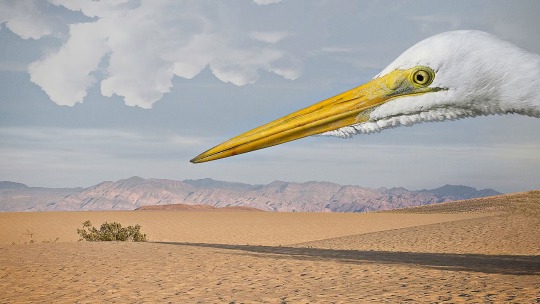
Great Egret In the Desert, 2012 This close up, photographed at J.N. Ding Darling Wildlife Refuge on Sanibel Island in Florida, is juxtaposed against the Mesquite Flat Sand Dunes in Death Valley.
The Art of Birds, Revealed Through an Altered Reality
— By Becky Harlan • Published: June 30, 2015 | Saturday April 27, 2024 | All Images Created By Cheryl Medow
At first glance, these birds wowed me. A few seconds later I started to wonder, Are they real?
Well … Yes. And No.

Grey Crowned Cranes Each crowned crane was photographed on an acacia tree near Richards Camp in Masai Mara, Kenya. Mount Kenya was photographed from a Cessna.
Before attempting to explain what’s going on in these images, the artist, Cheryl Medow, might appreciate you taking a similar approach to experiencing her photography as she does to making it. “I don’t think my pictures through,” she says, “I feel them.”
She described this incident to me: Visitors at one of her gallery shows were asking questions about how she creates her work, and she was answering. But then a guest approached her and said, “No, no, no, don’t say a thing. I just want to enjoy these pictures.” It was then that she realized that she was looking for an emotional reaction, for people to enjoy looking at the work without having all the answers.
So please: Look. Enjoy. Feel.
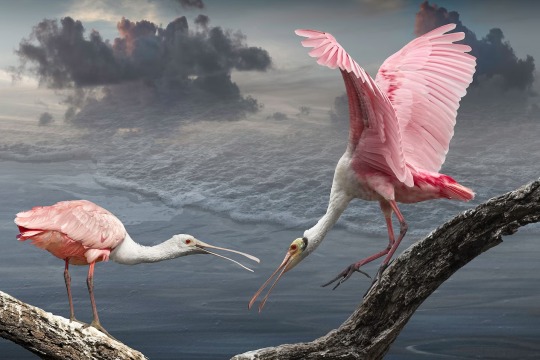
Roseate Spoonbills Each bird was photographed at St. Augustine’s Farm in Florida. This is where they nest in the spring. The waves were shot in Hanalei Bay, Kauai.
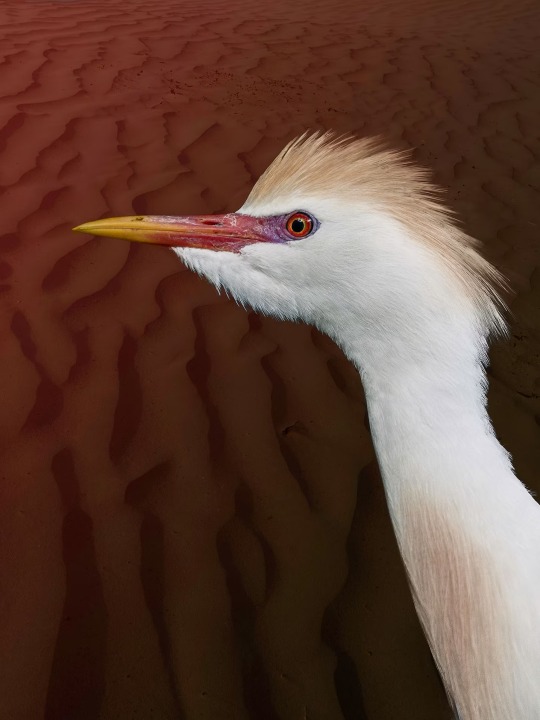
Cattle Egret Portrait ”During mating season the cattle egret colors are like a rainbow,” says Medow. This portrait was photographed in Florida, with the pattern of sand dunes from Death Valley in the background.

White Ibis With Fish This white ibis with his seaweed and fish catch were photographed at J.N. Ding Darling Wildlife Refuge on Sanibel Island, Florida. The background clouds and surf were shot in Hanalei Bay, Kauai.
But if you’re like me, you still want to know the story behind these images. So here goes.
These are real birds, photographed in the wild. They are also pictured in real landscapes. And both parts of the images are photographed by Medow. But they weren’t captured at the same time and often not in the same place.
Why does she go to the trouble of capturing these stunning birds in the wild and then transposing them somewhere else?

Great Blue Heron With Chicks Balancing on a branch, the great blue heron was photographed at the Venice Rookery in Venice, Florida, along with the chicks in a nest. The background was photographed in Bigfork, Montana.
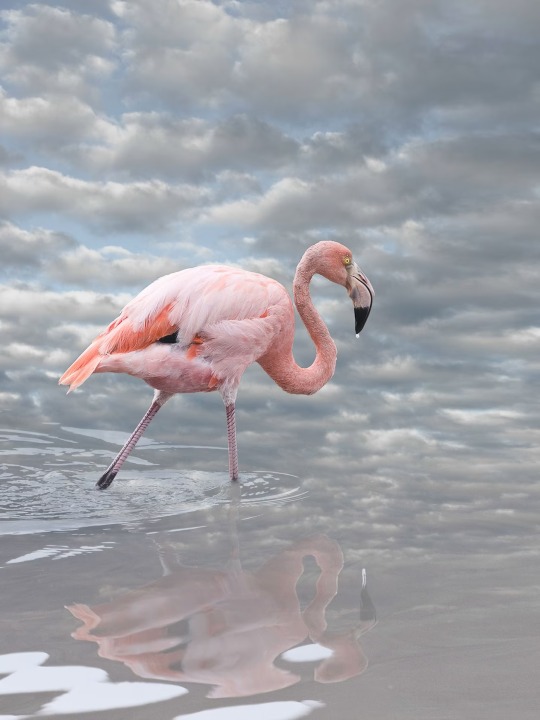
Greater Flamingo I This flamingo was photographed on Isabela Island in the Galápagos in a brackish saltwater lagoon. The clouds were also photographed in the Galápagos on a different day.
It all started because she was photographing birds with a 600mm lens. And when you shoot birds with a lens that long, the rest of the background becomes blurry—the birds wind up being the only thing in the frame that’s in focus. All context is lost. She wanted to put the birds back into an environment, so she began creating composite images.
At first she was just placing the birds into photos of the landscapes where she’d originally shot them. But then she realized she could take it to another level—she could put the birds anywhere and at any scale.
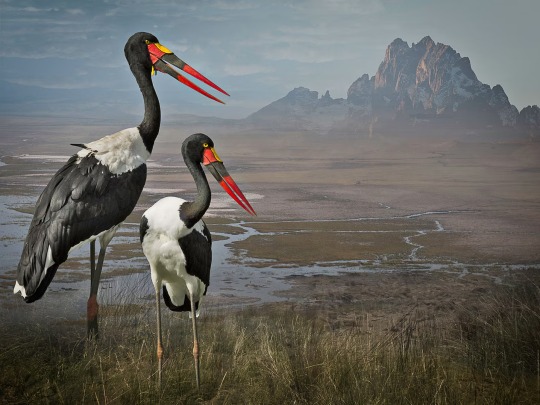
Saddle-Billed Storks This mother and baby were photographed in the Masai Mara Game Reserve. The landscape was shot by plane in the same area, traveling from Sirikoi Lewa Wildlife Conservancy in Laikipia to Richards Camp in Masai Mara.
“I’m an artist first, and photography is a tool that I use to be creative,” she says. “When I picked up the camera and the computer it opened up new possibilities for me. I can make the birds much larger than life. It draws attention to these guys that if you just saw them in the wild with the naked eye you wouldn’t see.”
She draws inspiration from the Hudson River School painters. “They took their sketchpads and went out, as I take my camera and go out, and they got sketches of all these different things. And when they went back to their studios and made their paintings, they combined the different elements that they had seen out in the field. So when the normal person went to the Hudson River and looked for the pictures they couldn’t find some of them. And that’s because they weren’t out there in the real world. Even the painters had manipulated what they had seen and brought it together and combined different elements to make their paintings,” she says. “They’re redoing nature in their mind’s eye, and I guess I’m doing that too.”
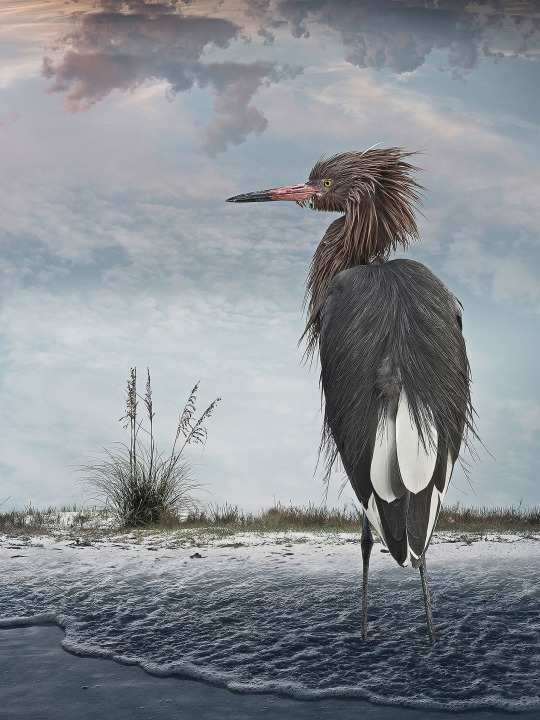
Reddish Egret This bird was photographed at Little Estero Lagoon, Fort Myers Beach, Florida. The landscape was also shot in Fort Myers at a different time.
Her subjects come from all over the world. Kenya, Tanzania, Botswana, South Africa, Los Angeles, New Mexico, the Galápagos, Costa Rica, and Brazil are some of the places she’s traveled to photograph birds. She’ll often photograph at a certain place during a certain season to see, for instance, an egret in its mating plumage. “I’ll pick April and May to go to Florida because that’s when they’re in their mating colors,” she says.
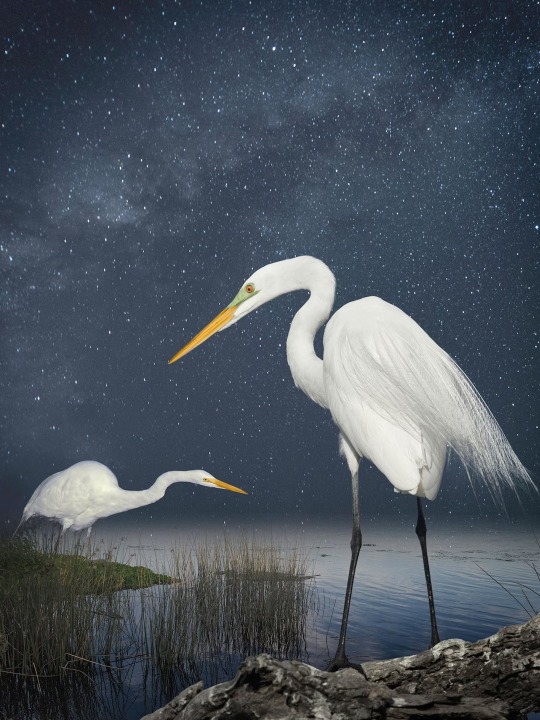
Great Egrets, A Starry Night The egrets were photographed in St. Augustine, Florida, and Devereux Lagoon and Slough, Santa Barbara, California. The night sky was photographed in Hanalei Bay, Kauai.
Some might think that because these images involve Photoshop in their final state that the painstaking work of photographing a bird in the wild is somehow less work. But Medow assures me that capturing these creatures in the wild isn’t for the hurried. “When I go out and shoot birds there’s a real Zen, a meditative state. Patience is something that I think is a wonderful asset to have, and I don’t usually use it in my normal life, so when I go out in the field I can almost zone out. I could sit there for hours waiting for birds to come and go,” she says. “They’re wild. They’re really wild. They can fly away. There’s something about that that’s just intriguing to me.”
#Birds 🐦 🦢 🦅#Arts#Photography#Proof#Miscellaneous Birds 🦢 🦅 🦜 🦆#Flamingo 🦩#Roseate Spoonbills | White Ibis#Great Blue Heron#Saddle-Billed Storks | Reddish Egret#Grey Crowned Crane#Great Egret
1 note
·
View note
Text
Michael Hambouz
gets a mention by Two Coats of Paint in their Hudson Valley (and vicinity) Selected Gallery Guide: March 2024 for “Loves Cats, Hates Catastrophes” at Elijah Wheat Showroom. He likes to play with language and optics and is not always dedicated abstractionist- Hambouz’s delicately crafted works of art, infused with an autobiographical element, break a mold of surface and allow viewers to see…

View On WordPress
0 notes
Text
"Last Sighting" at Roxbury Art's "Forgotten Spaces" through April 13, 2024-
I’m pleased to share my contribution to Roxbury Art’s current exhibition “Forgotten Spaces” at the Walter Meade Gallery in Roxbury NY, on view through April 13th, 2024.
The Last Sighting refers to the remembered rural landscapes of my youth. Landscape can be an unspoken part of identity, and I feel deeply connected to those places which now are just part of visual memories which keep changing over time. I grew up in the farmlands of the Mid-Hudson Valley. This work depicts a hillside and stand of trees which were later cleared for development. When I was younger, my siblings and I explored the countryside with the vague sense of ownership over places that children often feel. But the terrain is unrecognizable to me now, and so the last sightings are only in my imagination and paintings.
In this painting, I kept the aesthetic minimal and contemplative in palette and mood. To echo the vagueness which memories evoke, I left out detail and strived to keep the forms suggestive rather than defined or detailed.
The opening of the show last weekend was spectacular. It was great to meet so many of the participating artists, and the other works in the exhibit were beautiful, intriguing and evocative of the theme, each in its own unique way. I highly recommend visiting the show if you are in the Roxbury/Catskills area. And it was great to meet Ursula Hudak who did an outstanding job putting the show together, as well as Jenny Rosenzweig, who is Roxbury Arts’ Executive Director. I was really impressed by everything about the space and the organizers.
“Last Sighting” is available for sale. It’s framed in a beautiful dark walnut floater frame and available for the very alluring price of $875. If you are interested in this piece or know someone who might be, please contact Ursula Hudak at the gallery: [email protected] or call Roxbury Arts during business hours at 607-326-7908.
Here are some pictures and media from the opening- enjoy!
0 notes
Text
Exploring the Diverse Art Gallery Scene Near New York: A Journey Through Artistic Expression
Delving deeper, top galleries in NYC specialize in specific artistic movements, offering focused collections and in-depth knowledge. Photography enthusiasts can rejoice at the International Center of Photography, showcasing historical and contemporary works that capture the human experience. For those drawn to modern and contemporary art, Dia: Beacon, nestled amidst the Hudson Valley's scenic beauty, provides a serene setting to contemplate masterpieces by Andy Warhol, Agnes Martin, and others. If your passion lies in African American art, The Studio Museum in Harlem offers a vital platform for established and emerging Black artists, fostering dialogue and celebrating cultural heritage.
0 notes
Text
cv
cv.
zoë a. argires
b. 1996 Birmingham, AL, USA
based in Lancaster, PA, and New York, NY
Solo Exhibitions
2023
Minor Attractions, gallery Albany: British Fountain 1, London, UK
2021
Spider Gallery, Thong Paintings, Wichita, KS.
Robin Winters’ Key Club, Animal Crossing New Horizons, New York, NY.
2020
Art Death, 2020 Drawings, New York, NY.
Two-Person Exhibitions
2020
New Works, ☀ , Chicago, IL.
2019
OOF Books, ZAA + JLR Drawings on Paper, Los Angeles, CA.
Selected Group Exhibitions
2023
Cornershop and Minor Attractions: Beauty Tech Art Spa, London, UK.
M+B, My Condolences, Los Angeles, CA.
2022
NADA Foreland, JAG projects, Hudson, NY.
White Columns, Annual Benefit Auction, New York, NY.
gallery, Image Unavailable, Albany, NY.
On View, One Sec, New York, NY.
2021
Real Pain Fine Arts, The Frog Show, New York, NY.
Public Access, Devolve, New York, NY.
Nepenthes, Who Me?, New York, NY.
2020
Robin Winters’ Key Club, Friendz, New York, NY.
Serving The People, Self Portrait, New York, NY.
West 121st Street Projects, About the 77 Street Woman, New York, NY.
2019
Go To Heaven, Enduring Violence, Miami, FL.
5-50 Gallery, Not En Vogue, New York, NY.
PSLA, And me/us, Los Angeles, CA.
2018
Gallery MC, 2018 International Young Artist Group Exhibition, New York, NY.
Rema Hort Mann Foundation at Galerie Richard, Buy What You Love, New York, NY.
The Sleepcenter, Growing Pebbles, New York, NY.
2017
Petrie Museum, The Object Habit, London, UK.
The Hole, Got It For Cheap, New York, NY.
Arebyte, WOHS TIHS, London, UK.
Central Saint Martins, We Are Fans, London, UK.
Selected Curatorial Projects
2022
gallery, Image Unavailable, Albany, NY.
2020
Essex Flowers, Amogus, New York, NY.
International Pencil, online exhibition.
Robin Winters’ Key Club, Friendz, New York, NY.
Residency
The Macedonia Institute, September 2023, Hudson Valley, NY.
0 notes
Text
5 Unforgettable Day Trips From New York City You Cannot Miss
New York City is a vibrant and bustling metropolis, but it's also surrounded by a wealth of exciting day trip destinations. Whether you're interested in history, nature, culture, or simply escaping the city for a day, there are plenty of unforgettable day trips you can take from NYC. Here are five you cannot miss:
The Hamptons, Long Island: Located on the eastern tip of Long Island, the Hamptons are famous for their picturesque beaches, upscale restaurants, and charming villages. You can relax on the beautiful beaches of Southampton or East Hampton, explore the art galleries in Sag Harbor, and enjoy some of the freshest seafood at local restaurants. The Hamptons are a great escape from the city's hustle and bustle, especially during the summer.
Storm King Art Center: If you're an art enthusiast or just love the outdoors, a day trip to Storm King Art Center is a must. Located about an hour's drive north of the city in the Hudson Valley, this outdoor sculpture park features massive works of contemporary art set against a stunning backdrop of rolling hills, meadows, and forests. It's a unique blend of art and nature.
Philadelphia, Pennsylvania: Hop on an Amtrak train or take a bus to Philadelphia, just a 90-minute ride from NYC. Explore the birthplace of American democracy by visiting Independence Hall and the Liberty Bell. The city also offers world-class museums like the Philadelphia Museum of Art and delicious Philly cheesesteaks to enjoy.
Bear Mountain State Park: If you're a nature lover, head up to Bear Mountain State Park, located about an hour's drive north of NYC. It's a perfect destination for hiking, picnicking, and taking in scenic views of the Hudson River. You can also visit the Trailside Museum and Zoo or take a boat ride on Hessian Lake.
Princeton, New Jersey: Just an hour's train ride from NYC, Princeton is known for its prestigious university and charming downtown. You can tour the beautiful Princeton University campus, visit the Princeton University Art Museum, and stroll through the picturesque streets lined with boutiques and eateries. Don't forget to stop by the historic Nassau Inn for a meal.
These day trips offer a diverse range of experiences, from relaxation to adventure, and are perfect for a quick escape from the city's hustle and bustle. Whether you're interested in art, history, nature, or simply exploring new places, there's something for everyone within a short distance from New York City.
5 Unforgettable Day Trips From New York City You Cannot Miss
0 notes
Text
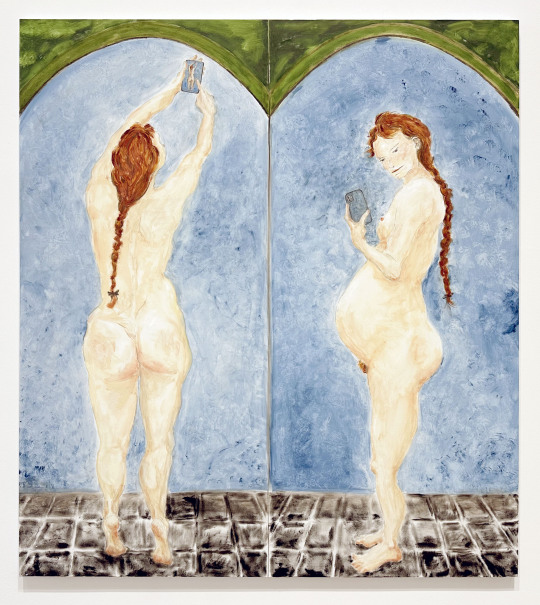
“New body, new body”, 2024, Oil and graphite on linen

“Our family portrait/ Dancing over the town”, 2024, Oil and graphite on linen
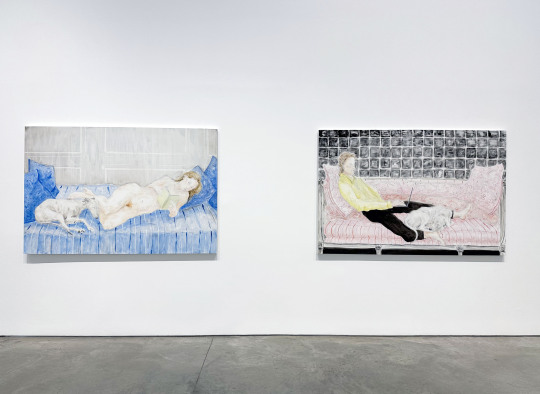
“In Bed” 2024, and “The world was different when Leonard painted Emily”, 2024, Oil and graphite on linen
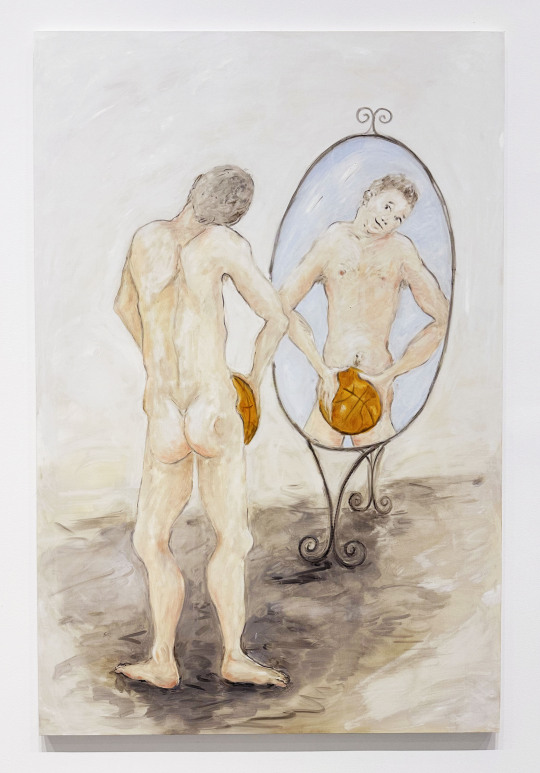
“I love basketball”, 2024, Oil and graphite on linen
Tanya Merrill’s exhibition, Watching women give birth on the internet and other ways of looking, at 303 Gallery explores the way we look at the world today, while referencing classical imagery from the past. What has changed in the way we see ourselves, our place in society, and our place in time? How much has changed because of self documentation and the internet? All of these questions feel even more prevalent now with technology and environmental issues moving at an accelerated pace.
From the press release-
True to her propensity for a cyclical and narrative installation, the show begins and ends with the creation of life. Each painting represents a diverse point of interest and concern to the artist— sexuality and ideas of fertility, the natural world and the fraught state of the environment, and the broader implications of contemporary technology, sports, and religion on the artist’s experience as a woman today.
The scale of the subjects in each canvas approximate life, creating a one-to-one perspective when standing in front of, say, a tree trunk, a cat perched on a fish tank, or a man admiring himself with a basketball. One work shows a trompe l’oeil stack of papers illustrating a 15th century manuscript: an early representation of a woman’s fertility cycle in relation to the stars. The modes for distributing images have changed, but the need to see them has not—jump ahead 800 years and the show’s namesake painting frames the edge of a computer screen, documenting the recent phenomenon of sharing one’s birthing story and corresponding photographs publicly on the internet.
Humans have always employed tools for looking. The earliest manufactured mirrors were made from volcanic glass in Turkey and date some 8000 years ago, the invention of the telescope advanced our understanding of Earth’s place in the cosmos, a phone now captures our own image with a recent poll finding 92 million selfies are taken every day around the world: the Allegory of Sight and mythology of Narcissus regenerates. In I love basketball, a naked man gazes affectionately at himself in the mirror. Coyly, he holds a basketball in front of his own genitalia; pensive yet playful, he engages the long tradition of masculinity in sports seen throughout art history. Across the gallery, a pregnant woman is doubled in the frame and photographs her changing body. The technology she clutches, perhaps soon to be obsolete, will be inextricably linked to the start of the 21st century.
The North American cecropia moth is seen on its host plant, a white birch tree, one of the few plants a Cecropia larva can eat. A recent report found dramatic rates of decline that may lead to the extinction of 40% of the world’s insect species over the next few decades. And with a single nest of baby birds needing up to 9,000 caterpillars before they are ready to fledge, the looming demise and precarity of our food chain is blatant. Merrill is compelled to paint the species that are still here, a record that they really did live before they died. The ecologist David Wagner says of the insect decline, “… We don’t know if it’s an apocalypse or Armageddon.”
In Our family portrait/ Dancing over the town, three skeletons– two human and one dog– are seen romping joyfully, even in death. The couple, winged and facing eternity together, point to religious imagery from a 17th century wall tomb, while the surrounding landscape references the art movements of Europe which inspired the Hudson River School Painters— an homage to the place this exhibition was made. Merrill’s studio in the Hudson Valley can be seen nestled in the bottom left corner of the canvas.
This exhibition closes 5/18/24.
#Tanya Merrill#303 Gallery#303 Gallery NYC#Art#Art Shows#Chelsea Art Galleries#Chelsea Art Shows#Fertility#Life and Death#New York Art Shows#NYC Art Shows#Painting#Selfies#Technology
1 note
·
View note
Text
Ginger Radio Hour #033
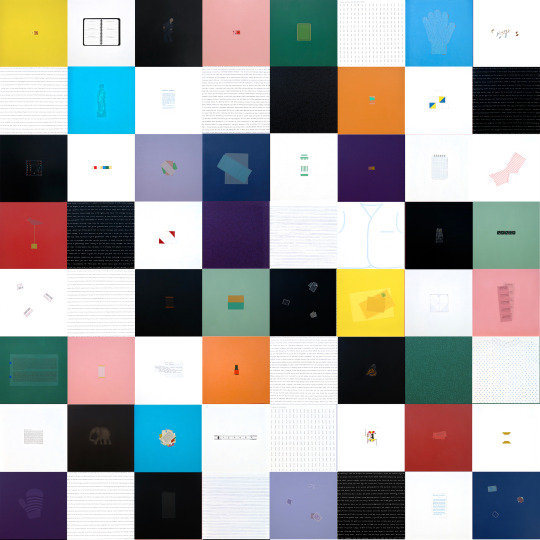
Show Notes February 7, 2023
Listen to archived episode.
Theme: Color, text, past.
Featured: Hudson Valley-based artist Fern Apfel is a still life painter who focuses on remnants of the past, including diary pages, letters, books, and illuminated manuscripts. Our conversation took place at her solo exhibition of paintings in the Main Gallery of the Art Center of the Capital Region in Troy. The show runs through Feb. 25th. Read more about the show.
Playlist:
The Clash “Jimmy Jazz (Remastered)” Album: London Calling (Remastered) 1979
Dirty Projectors “Two Doves” Album: Bitte Orca 2009
Stereolab “Intervals” Album: Electrically Possessed (Switched On Volume 4) 2021
Nina Simone “Do I Move You?” Album: The Essential Nina Simone 1999
Plus tracks from Colours of Air, the new album by Loscil and Lawrence English:
Cyan
Aqua
Yellow
Pink
0 notes